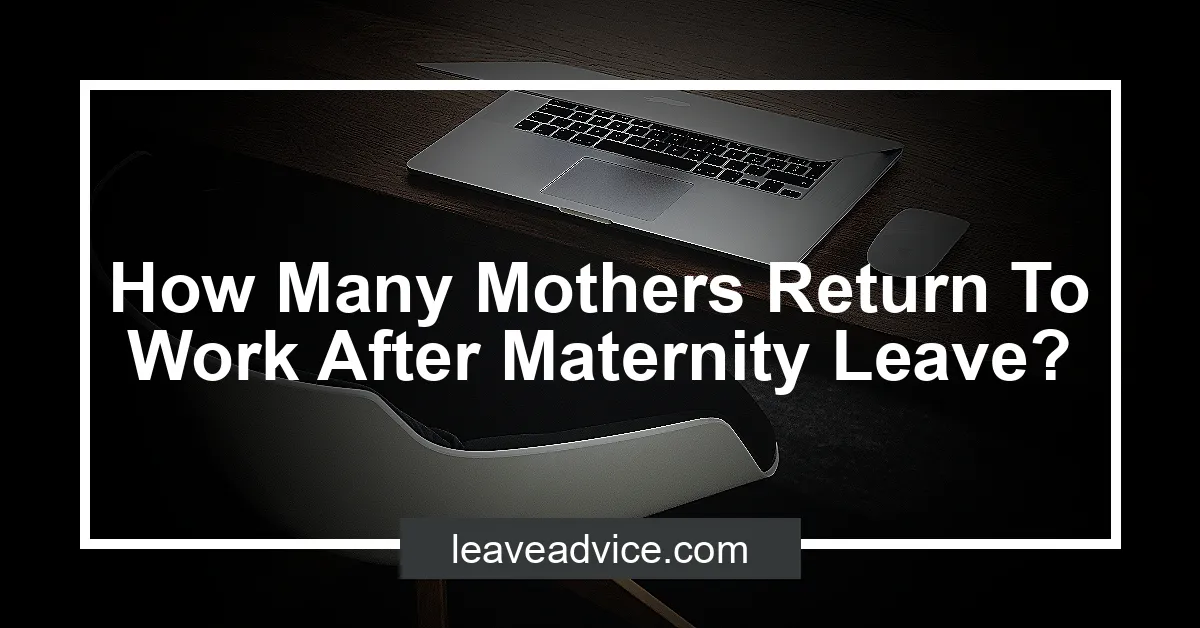How Many Mothers Return To Work After Maternity Leave?


When it comes to maternity leave, many mothers face the tough decision of whether to return to work or stay at home to care for their newborn child. This decision is influenced by various factors such as financial stability, career aspirations, and personal desires. In this article, we will explore the statistics and factors that contribute to the decision of how many mothers return to work after maternity leave.
The Statistics: How Many Mothers Return to Work?
Over 50% of women return to work after their maternity leave. Among U. S. job seekers, this share was even higher at 58%. This indicates that a majority of mothers choose to go back to work after their maternity leave. However, it is important to note that returning to work does not necessarily mean returning to the same level of work hours as before. Only 24% of women returned to their pre-maternity hours, while 57% left the workforce entirely.
A survey conducted on 2,000 employed moms of school-aged children found that six in 10 moms went back to work, but with reduced hours. This indicates that many mothers opt for part-time work or flexible schedules in order to balance their responsibilities as parents.
Factors Influencing the Decision
-
Financial Stability: One of the main factors that influence the decision of whether to return to work is the family’s financial stability. Many mothers feel the need to contribute to the household income and maintain their financial independence. This becomes especially important if the family relies solely on one income.
-
Career Aspirations: For some mothers, returning to work after maternity leave is driven by their career aspirations. They may have worked hard to establish their careers and do not want to put them on hold for an extended period of time. Returning to work allows them to continue their professional growth and maintain their position in the workforce.
-
Personal Desire: Some mothers simply enjoy their work and find fulfillment in their careers. They may feel a strong sense of identity tied to their job and find it difficult to completely let go of their professional lives. Returning to work allows them to strike a balance between motherhood and their personal fulfillment.
-
Guilt: Despite the desire to return to work, many mothers also experience guilt about leaving their child in childcare or with a caregiver. This guilt can be overwhelming and may lead some mothers to reconsider their decision to return to work. It is important for society to create a support system that acknowledges and addresses this guilt, allowing mothers to make the decision that best suits their individual circumstances.
Recommendations for Working Mothers
For mothers who choose to return to work after maternity leave, it is important to prioritize self-care and establish a support system. Here are some recommendations:
-
Flexible Work Arrangements: Seek out employers who offer flexible work arrangements such as remote work, part-time hours, or flexible schedules. This allows mothers to balance their work and family responsibilities more effectively.
-
Childcare Options: Research and explore different childcare options to find the one that best suits your needs and preferences. This can alleviate some of the guilt and concerns about leaving your child in the care of others.
-
Open Communication: Maintain open communication with your employer and colleagues about your needs as a working mother. This can help create a supportive work environment and ensure that your needs are met.
-
Self-Care: Make time for self-care activities to prioritize your well-being. This can include exercise, hobbies, or spending quality time with your child. Taking care of yourself will enable you to be more present and effective in both your work and family life.
Recommended Amazon Product: Ergonomic Baby Carrier
One product that can be beneficial for working mothers is an ergonomic baby carrier. This allows you to keep your baby close while having the flexibility to move around and complete tasks. It provides comfort and support for both you and your child, making it easier to juggle between work and parenting responsibilities.
My recommended search term for the Amazon product would be “Ergonomic Baby Carrier”. This search term will lead you to a variety of trusted and popular brands offering ergonomic baby carriers that suit your needs.


Investing in an ergonomic baby carrier can be a game-changer for working mothers, as it provides convenience, comfort, and bonding opportunities with your child.
Conclusion
While the decision of whether to return to work after maternity leave is a personal one, statistics show that over 50% of women choose to go back to work. Factors such as financial stability, career aspirations, and personal desires all play a role in this decision. It is important for society to support working mothers and provide them with the necessary resources and flexibility to navigate the challenges of balancing work and family life.
In conclusion, the journey of motherhood is unique for every woman, and the decision to return to work after maternity leave is influenced by various factors. By understanding and supporting the needs of working mothers, we can create a more inclusive and supportive environment for all.
- Recommended Amazon Product: Ergonomic Baby Carrier



